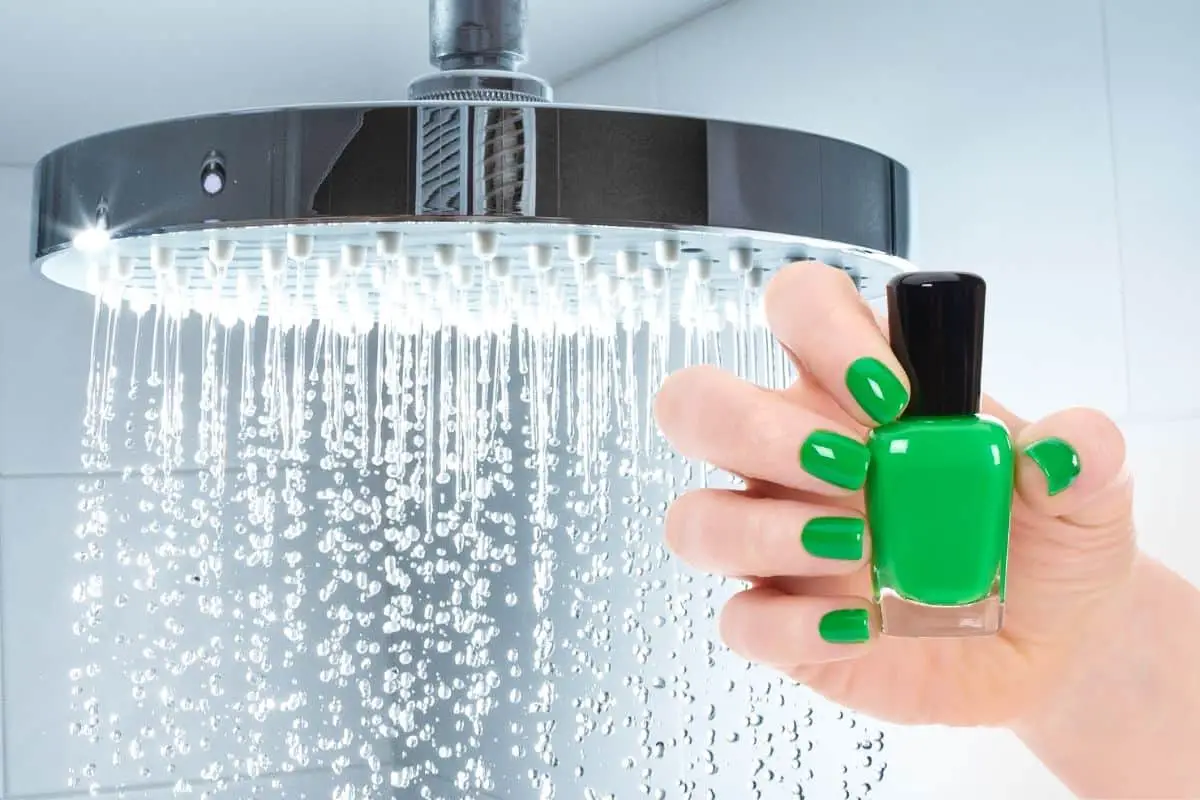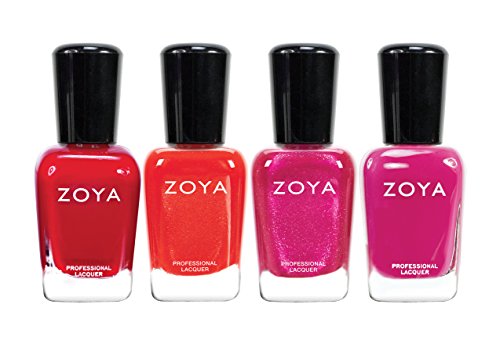This post contains affiliate links.
There is nothing better than freshly manicured nails. In order to keep the shine and the color lasting for a long time, you need to take care of your nails, especially if you are going for regular nail polish.
But that is one of the most annoying things about regular nail polish – it is not made to last for weeks, rather it only lasts for a few days, and if you spend a lot of time under a shower, you are lucky if you get 2 days in a row.
To prevent the nail polish from peeling off in the shower, the best advice is to prepare the nails and apply the nail polish properly. This means that you should apply the base and top coat in a way that they lock the nail polish in place and prevent the water from penetrating the polish thus destroying it.
If you want to prolong the duration of your manicure, first you need to understand how and why the water causes the nail polish to lift off your natural nails. Once you understand this, it will be easy to keep the nails fresh for up to a week.
Table of Contents
Why Is It Happening?
The reason behind this is because regular nail polish was not made from a long-lasting formula. Instead, it is commonly made from a polymer that is known for its short life span, especially if you keep your hands a lot under the water, or you are using any abrasive substances.
Even after the first day, you may experience nail polish chipping and peel off your nails after a hot shower or a bath. There is a scientific reason behind this, and there is also a way to prevent it from happening.
Although no solution can prolong nail polish duration for an indefinite time, it can for sure prevent it from ruining your manicure so quickly.
When you watch it under a microscope, nail polish is simply another layer on top of your natural one, that has one function – to prevent the loss of hydration and oils. Although this may sound contradictory because nail polish can dehydrate the nails in the first place, let me explain the logic.
Natural nails, without any coating, are having around 18% of water and 5% of oils. When water droplets fall onto a natural nail, it simply slides off the nails. When there is another layer on top, in a form of nail polish, it is a different story.
Although it may seem that nail polish creates an impenetrable layer that’s protecting natural nails, in reality, water can still penetrate the nail polish, but at a much slower rate. If the nail polish is poorly applied, the degradation of it is much faster.
Once the water reaches underneath the nail polish, it starts to dissolve, causing the nail polish to break and eventually chip off the nails in pieces. This is more likely to happen if your hands are constantly underwater, for example when you are washing dishes or taking a shower.
This process is unavoidable, meaning it cannot be stopped or reversed. The only thing you can do is to slow it down, firstly by avoiding water as much as you can. This doesn’t mean to stop washing your hands, it simply means that you need to find alternative ways to do your everyday tasks.
So for example, if you are washing a lot of dishes, then maybe you should try using gloves. This will still expose your nails to some level of moisture, but not as much as they would be exposed without gloves.
How Do You Shower with Painted Nails?
Let me just take a moment to explain what happens to your nails during the shower specifically. I have already explained why it is happening, here I will explain how it is happening.
Every nail surface is unique – just like a fingerprint. Although it may seem very smooth, it is actually very uneven, consisting of many tiny curves that are most of the time unnoticeable to the human eye. When you apply nail polish that is in a liquid state, it naturally adjusts to those curves and dries according to them, creating a specific pattern.
Because the nail surface is made from water as well, when it touches it, it tends to soak some percentage and the surface flattens out. Now, this creates a disbalance between a flat surface and a curvy nail polish that has already dried according to the original “mold”.
During the years, the nail polish formula has been changed and enhanced, so the nail polish is actually able to create a plasticized layer that can bend with the natural nail up to some point.
This basically means that 5 minutes under the water will not damage the nail polish as much as it would a 15-minute shower. This is why time under the water is also very important.
After only 10 to 15 minutes, water will travel through the nail polish to the base, thus removing the bond that was created between the nail polish and the natural nails. Because of this, there is nothing more that’s holding the two layers together, and the nail polish starts to fall apart.
Sometimes the nail polish wouldn’t even break, it would peel off in one piece if the damage the water had done was excessive. This also means that the nail polish itself didn’t adhere to the natural nails as it should.
To prevent this from happening, there are a few pieces of advice you could follow. Of course, this doesn’t guarantee your nail polish would not peel off instantly, there are many things that you need to do right, and they are all listed in the following text.
Use Alcohol
A good tip before you start even applying nail polish is to use alcohol to wipe off the surface of the nails. This will clean the nails and remove any oils that may have built up. It is crucial not to skip this step because if you want to ensure the duration of any kind of manicure, not just regular nail polish, you need to prepare the nails correctly.
The base coat usually requires that the nail surface is clean and rough, so it can adhere to it. Since the base coat is supposed to act as a glue between the natural nails and the nail polish, it is crucial to apply it correctly.
The only way to ensure the nail surface is clean is to use alcohol because it has shown that it is the most efficient in removing any excess oils and leaving the surface clean and ready for a new layer of polish.
If you don’t have any alcohol, you can use acetone instead. Just make sure that you are not using too much of any of these products because they can dehydrate the cuticles and create issues of another kind.
Apply Base Coat Properly
This step is as crucial as the one before. If you don’t use a good base coat, there will not be a proper bond created between the natural nails and the nail polish. If the bond is not good, the manicure would not last long.
It is important not to skip the base coat because the base coat is formulated in a way that it bonds with the natural nails. On the other hand, nail polish is formulated in a way that bonds with the base coat.
If there is no base coat for the nail polish to bond to, the nail polish would still stick to the natural nails, but the duration would be limited to a day or two. It would be very easy for the water to destroy the apparent bond.
Use very little base coat – if you use too much, chances are that it will not dry properly before you apply nail polish on top, and then it’s like you didn’t do anything. Always wipe the brush from the tip of the bottle to remove any excess base coat you may have picked up.
When you are painting the base coat, make sure to “lock” the nails, meaning that you start from the base of the nail, slowly moving to the tip, making sure that you are covering as much surface as you can.
Once you reach the tip, paint over it, to lock it in place and prevent the water from coming in that way. This is the most common mistake that makes your nail polish chip off after a few days. A simple trick that can prolong your manicure.
If your nails are very short, chances are that when you paint it over the tip of the nails, you will apply some of the base coat to the skin as well. You can use an earbud to remove the base coat from the skin while it’s still wet, or you can remove it with a little bit of water once it dries.
It is recommended to remove it immediately from the skin or the cuticles, because later on, you may risk damaging the nail polish itself. If you remove too much of it, don’t worry, just reapply the base coat where you have taken off too much of it.
Let the Nail Polish Dry
Once you start applying the nail polish, it may seem like a good idea to apply a thick layer of it and let it dry, so you can reach the consistency and density of the color as you like. This is a bad idea because the thick layers can weaken the whole “structure” under the shower.
It is better to apply the nail polish in very thin layers, and if you are not satisfied with the color, you need to build it gradually. This means that in between each layer you should take a break from 3 to 5 minutes, which is usually enough time for one layer to completely dry.
A good trick to check if the layer is dry is by smell – if you no longer can feel the distinct smell of the nail polish, then the layer is dry. Never check it with your fingers, because if the layer is not dry, you would leave your fingerprint on the surface and ruin the manicure.
Once one layer is completely dry, apply another one. Apply a maximum of three layers, because more than this cannot be stable on the nails and it will allow water to quickly break through all of them.
Seal It with a Top Coat
Just like you should not skip the base coat, you should never avoid using a top coat. It is formulated in a way that it only bonds with the nail polish and it locks the shine in place.
A good top coat can prolong the life of the nail polish and can prevent it from losing its shine. Also, it is a good line of defense to some everyday damage that occurs during normal regular activities.
When you apply a top coat, follow the same aforementioned advice regarding base coat, and make sure to coat the whole surface where you have applied the nail polish. This will create a barrier between the nail polish and the water.
Although you have seen that the nail polish is not impenetrable, this will slow down the whole process and save the nails from chipping under a shower.
If you want to read more about top coat you can read it here.
Clean the Nails
After you finish with all the layers, apply a little bit of acetone to a cotton bud and clean the edges where you might have over-applied the nail polish or the base or top coat. By doing this you are removing any imperfections to the application that has occurred.
Nail polish is more likely to peel off from your skin and cuticles than it is from the nail itself. When you leave the polish on the skin, once it gets in touch with the water, it is very easy for the water to lift off all the layers and you can easily go out of the shower without your manicure.
Use acetone-based nail polish remover because it will work quicker than the non-acetone one, and it is less likely your skin would be left dehydrated. Of course, after you finish with the manicure, apply moisturizer to your nails and cuticles to give them the extra food they need.
Reapply When Necessary
If you really want to keep your nails shiny and fresh looking through a week of constant exposure to the water, this simple trick may do the work for you. Try to reapply a top coat on a daily basis.
This will fill in any tiny damages that might have occurred and will reinforce the barrier between the water and the natural nails.
I have to make one remark here – try to avoid 2 in 1 product that combines the base and top coat. As already explained, the base coat is formulated to bond with natural nails, while the top coat is formulated to bond with nail polish.
Mixing these two products in one and using them as a universal coat will not have any effect on the duration of your manicure. In fact, it can even speed up the chipping and breaking, so make sure to always apply the top and base coat separately.
Is It Better to Use Well-known Brands?
When it comes to regular nail polish, there is a dilemma whether well-known brands are really more durable and overall better than no-name brands. Some studies have tried to prove that well-known brands are better, but they are all inconclusive.
The reason for this is because the duration of the nail polish is very individual and cannot be generalized, even though some patterns can be recognized.
Well-known, high-end brands are more likely to last longer, simply because the formula is better and quality is on a much higher level. Tons of money has been thrown into the research and development of such a formula.
From this research, even some new hybrid products were born – like the Shellac – a specific transition between regular nail polish and gel, which comprises only the best from both types of manicure.
In the end, everything comes down to how you take care of your nails. If you are super careful, even the cheapest type of nail polish would last for days. But if you don’t apply the base and top coat correctly, even the most expensive one can lift and break off your nails after one day.
The best advice is to take precautions and take care, no matter if you are having regular nail polish or acrylics. Good preparation and application are the keys to long-lasting shiny nails.
Sources:
- Nailcarehq.com: Chipped nail polish from the shower
- Goodhousekeeping.com: Stop nail polish varnish chipping
- Nailstip: How to keep nail polish from peeling in
MakeupRestart.com is a participant in the Amazon Services LLC Associates Program, an affiliate advertising program designed to provide a means for sites to earn advertising fees by advertising and linking to Amazon.com. We also participate in other affiliate programs which compensate us for referring traffic.









Leave a Reply